The Adhesion Strength of Semi-Clathrate Hydrate to Different Solid Surfaces
Abstract
:1. Introduction
2. Materials and Methods
2.1. Materials
2.2. Experimental Apparatus
2.3. Experimental Procedure
3. Results and Discussion
3.1. The Temporal Evolution of Temperature during the Adhesion Measurement
3.2. The Effect of Solid Surface Wettability on Hydrate Adhesion Strength
3.3. The Effect of Solid Surface Roughness on Hydrate Adhesion Strength
3.4. The Effect of Subcooling on Hydrate Adhesion Strength
4. Conclusions
Author Contributions
Funding
Data Availability Statement
Conflicts of Interest
References
- Song, S.; Fu, S.; Liao, Q.; Shi, B.; Chen, H.; Gong, J. Investigations on methane hydrate formation, dissociation, and viscosity in gas-water-sand system. Petrol. Sci. 2022, 19, 2420–2430. [Google Scholar] [CrossRef]
- Sun, Y.; Cao, B.; Chen, H.; Liu, Y.; Zhong, J.; Ren, L.; Chen, G.; Sun, C.; Chen, D. Influences of pore fluid on gas production from hydrate-bearing reservoir by depressurization. Petrol. Sci. 2023, 20, 1238–1246. [Google Scholar] [CrossRef]
- Zhang, S.; Wang, L. Rotational failure analysis of spherical-cylindrical shell pressure controllers related to gas hydrate drilling investigations. Petrol. Sci. 2023, 20, 482–494. [Google Scholar] [CrossRef]
- Liu, J.; Wang, J.; Dong, T.; Liang, D. Effects of wax on CH4 hydrate formation and agglomeration in oil–water emulsions. Fuel 2022, 322, 124128. [Google Scholar] [CrossRef]
- Liu, S.; Han, T.; Fu, L. Laboratory insights into the effects of methane hydrate on the anisotropic joint elastic-electrical properties in fractured sandstones. Petrol. Sci. 2023, 20, 803–814. [Google Scholar] [CrossRef]
- Liu, H.; Li, H.; Yao, D.; Guo, P.; Wen, L. The research on the natural gas hydrate dissociation kinetic from hydrate-sediments/seawater slurries. Chem. Eng. J. 2022, 435, 135127. [Google Scholar] [CrossRef]
- Li, S.; Zhang, G.; Dai, Z.; Jiang, S.; Sun, Y. Concurrent decomposition and replacement of marine gas hydrate with the injection of CO2-N2. Chem. Eng. J. 2021, 420, 129936. [Google Scholar]
- Chen, J.; Zeng, Y.; Yu, X.; Yuan, Q.; Wang, T.; Deng, B.; Yan, K.; Jiang, J.; Tao, L.; Chen, C. A covering liquid method to intensify self-preservation effect for safety of methane hydrate storage and transportation. Petrol. Sci. 2022, 19, 1411–1419. [Google Scholar] [CrossRef]
- Gao, Y.; Xu, Y.; Song, K.; Li, Q.; Yao, H.; Chen, H.; Wang, W.; Li, Y. A New Calculation Method and Model of Hydrate Slurry Flow of The Multiphase Pipe in Deep Water Gas Field. J. Pipe. Sci. Eng. 2022, 3, 100104. [Google Scholar] [CrossRef]
- Chen, L.; Koh, C.; Sun, B. Insight into the plugging mechanism in water-continuous hydrate slurries. Fuel 2022, 316, 123360. [Google Scholar] [CrossRef]
- Liu, Y.; Lv, X.; Ma, Q.; Zhou, S.; Shi, B.; Du, H.; Lei, Y.; Yu, P.; Song, S.; Gong, J.; et al. Investigation on Synergistic Deposition of Wax and Hydrates in Waxy Water-in-Oil (W/O) Flow Systems. Petrol. Sci. 2022, 19, 1840–1852. [Google Scholar] [CrossRef]
- Lingelem, M.N.; Majeed, A.I.; Stange, E. Industrial Experience in Evaluation of Hydrate Formation, Inhibition, and Dissociation in Pipe Design and Operation. Ann. Ny Acad. Sci. 1994, 715, 75–93. [Google Scholar] [CrossRef]
- Wang, Z.; Zhang, J.; Sun, B.; Chen, L.; Zhao, Y.; Fu, W. A new hydrate deposition prediction model for gas-dominated systems with free water. Chem. Eng. Sci. 2017, 163, 145–154. [Google Scholar] [CrossRef]
- Wang, Z.; Yu, J.; Zhang, J.; Liu, S.; Gao, Y.; Xiang, H.; Sun, B. Improved thermal model considering hydrate formation and deposition in gas-dominated systems with free water. Fuel 2018, 236, 870–879. [Google Scholar] [CrossRef]
- Huang, L.; Kang, J.; Shen, X.; Sun, J.; Meng, Q.; Chen, Q.; Hu, G.; Liu, C.; Wu, N. Experimental investigation of hydrate formation in water-dominated pipe and its influential factors. China Geol. 2022, 5, 310–321. [Google Scholar]
- Chen, Y.; Gong, J.; Shi, B.; Yao, H.; Liu, Y.; Fu, S.; Song, S.; Lv, X.; Wu, H.; Lou, X. Investigation into methane hydrate reformation in water-dominated bubbly flow. Fuel 2020, 263, 116691. [Google Scholar] [CrossRef]
- Song, G.; Li, Y.; Wang, W.; Jiang, K.; Ye, X.; Zhao, P. Investigation of hydrate plugging in natural gas + diesel oil + water systems using a high-pressure flow loop. Chem. Eng. Sci. 2017, 158, 480–489. [Google Scholar] [CrossRef]
- Chen, J.; Yan, K.; Chen, G.; Sun, C.; Liu, B.; Ren, N.; Shen, D.; Niu, M.; Lv, Y.; Li, N.; et al. Insights into the formation mechanism of hydrate plugging in pipelines. Chem. Eng. Sci. 2015, 122, 284–290. [Google Scholar] [CrossRef]
- Taylor, C.J.; Dieker, L.E.; Miller, K.T.; Koh, C.A.; Sloan, E.D. Micromechanical adhesion force measurements between tetrahydrofuran hydrate particles. J. Colloid Interf. Sci. 2007, 306, 255–261. [Google Scholar] [CrossRef]
- Liu, C.; Li, Y.; Wang, W.; Dong, S.; Li, M. Modeling the micromechanical interactions between clathrate hydrate particles and water droplets with reducing liquid volume. Chem. Eng. Sci. 2017, 163, 44–55. [Google Scholar] [CrossRef]
- Aman, Z.M.; Leith, W.J.; Grasso, G.A.; Sloan, E.D.; Sum, A.K.; Koh, C.A. Adhesion force between cyclopentane hydrate and mineral surfaces. Langmuir 2013, 29, 15551–15557. [Google Scholar] [CrossRef] [PubMed]
- Zhang, W.; Fan, S.; Wang, Y.; Lang, X.; Li, G. Preparation and performance of biomimetic superhydrophobic coating on X80 pipe steel for inhibition of hydrate adhesion. Chem. Eng. J. 2021, 419, 129651. [Google Scholar] [CrossRef]
- Aspenes, G.A.; Dieker, L.E.; Aman, Z.M.; Høiland, S.; Sum, A.K.; Koh, C.A.; Sloan, E.D. 2010. Adhesion force between cyclopentane hydrates and solid surface materials. J. Colloid Interf. Sci. 2010, 343, 529–536. [Google Scholar] [CrossRef] [PubMed]
- Nicholas, J.W.; Dieker, L.E.; Sloan, E.D.; Koh, C.A. Assessing the feasibility of hydrate deposition on pipe walls—Adhesion force measurements of clathrate hydrate particles on carbon steel. J. Colloid Interf. Sci. 2009, 331, 322–328. [Google Scholar] [CrossRef]
- Matsumoto, K.; Murase, M.; Ehara, K.; Sakamoto, J.; Ueda, J. Investigation on adhesion force of TBAB hydrate to cooling copper surface. Int. J. Refrig. 2017, 78, 121–127. [Google Scholar] [CrossRef]
- Liu, C.; Yang, L.; Zhou, C.; Wang, Z.; Li, M. Effects of hydrate inhibitors on the adhesion strengths of sintered hydrate deposits on pipe walls. J. Colloid Interface Sci. 2022, 624, 593–601. [Google Scholar]
- Liu, C.; Wang, Z.; Tian, J.; Yan, C.; Li, M. Fundamental investigation of the adhesion strength between cyclopentane hydrate deposition and solid surface materials. Chem. Eng. Sci. 2020, 217, 115524. [Google Scholar]
- Liu, F.; Li, A.; Qing, S.; Luo, Z.; Ma, Y. Formation kinetics, mechanism of CO2 hydrate and its applications. Renew. Sus. Energ. Rev. 2022, 159, 112221. [Google Scholar] [CrossRef]
- Ammarullah, M.I.; Hartono, R.; Supriyono, T.; Santoso, G.; Sugiharto, S.; Permana, M.S. Polycrystalline Diamond as a Potential Material for the Hard-on-Hard Bearing of Total Hip Prosthesis: Von Mises Stress Analysis. Biomedicines 2023, 11, 951. [Google Scholar] [CrossRef]
- Ammarullah, M.I.; Santoso, G.; Sugiharto, S.; Supriyono, T.; Kurdi, O.; Tauviqirrahman, M.; Winarni, T.I.; Jamari, J. Tresca stress study of CoCrMo-on-CoCrMo bearings based on body mass index using 2D computational model. J. Tribologi. 2022, 33, 31–38. [Google Scholar]
- ISO 630-1995; Structural Steels—Plates, Wide Flats, Bars, Sections and Profiles. ISO: Geneva, Switzerland, 1995.
- Young, T. An essay on the cohesion of fluids. Phil. Trans. R. Soc. Lond. 1805, 95, 65–87. [Google Scholar]
- Fowkes, F.M. Attractive forces at interfaces. Ind. Eng. Chem. 1964, 56, 40–52. [Google Scholar] [CrossRef]
- Good, R.J. Contact angle, wetting, and adhesion: A critical review. J. Adhes. Sci. Technol. 1992, 6, 1269–1302. [Google Scholar] [CrossRef]
- Wenzel, R.N. Resistance of solid surfaces to wetting by water. Ind. Eng. Chem. 1936, 28, 988–994. [Google Scholar] [CrossRef]



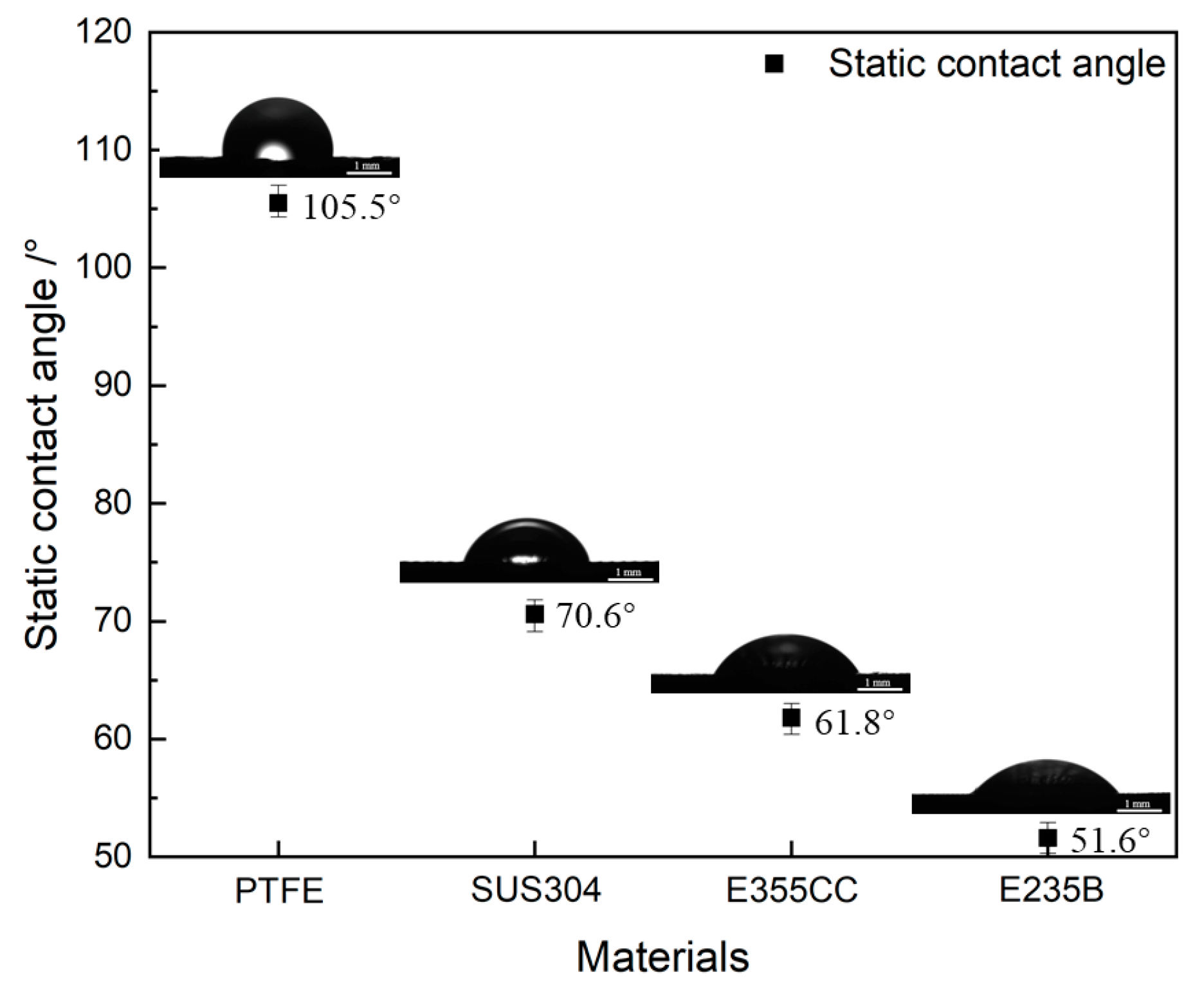

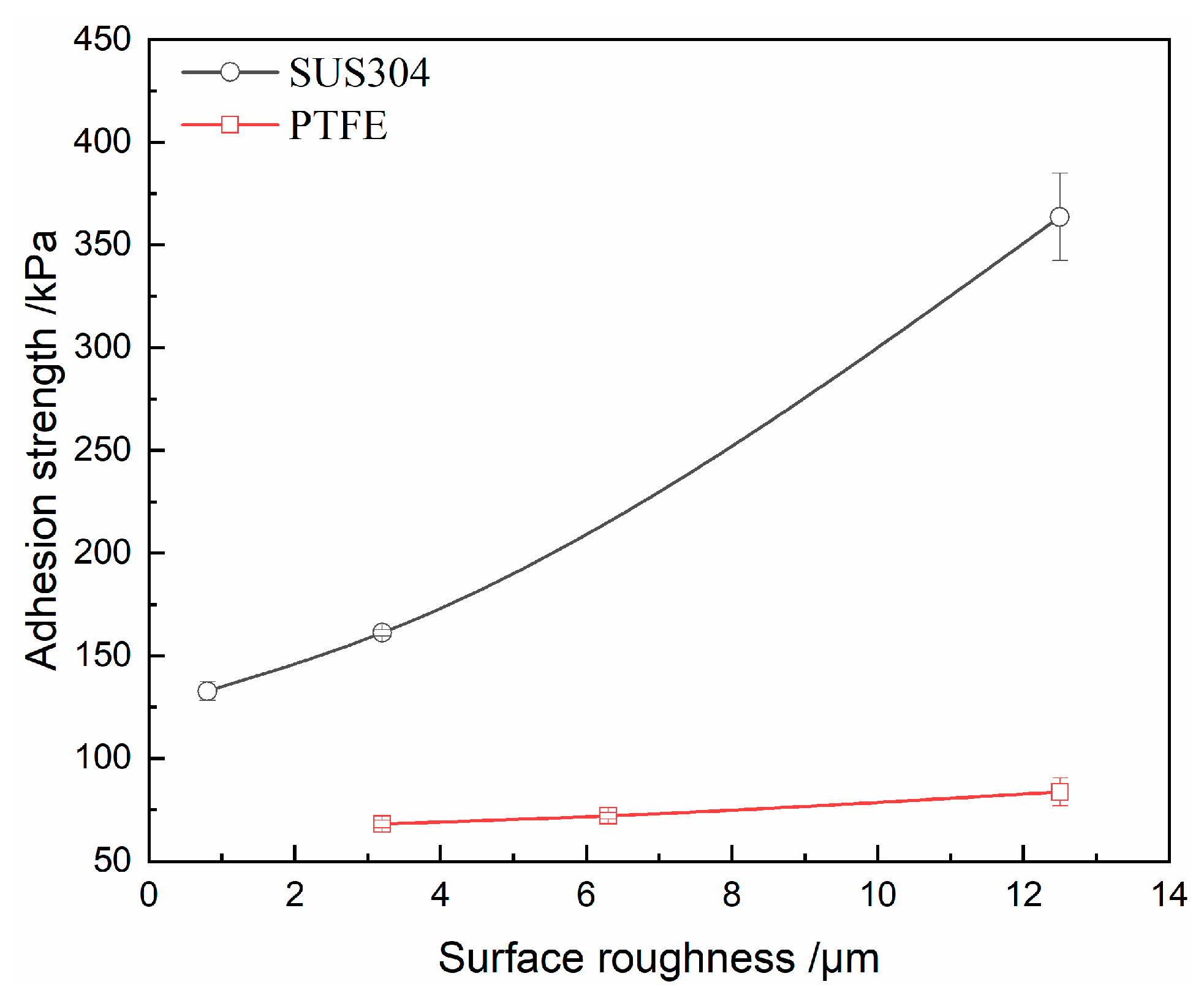
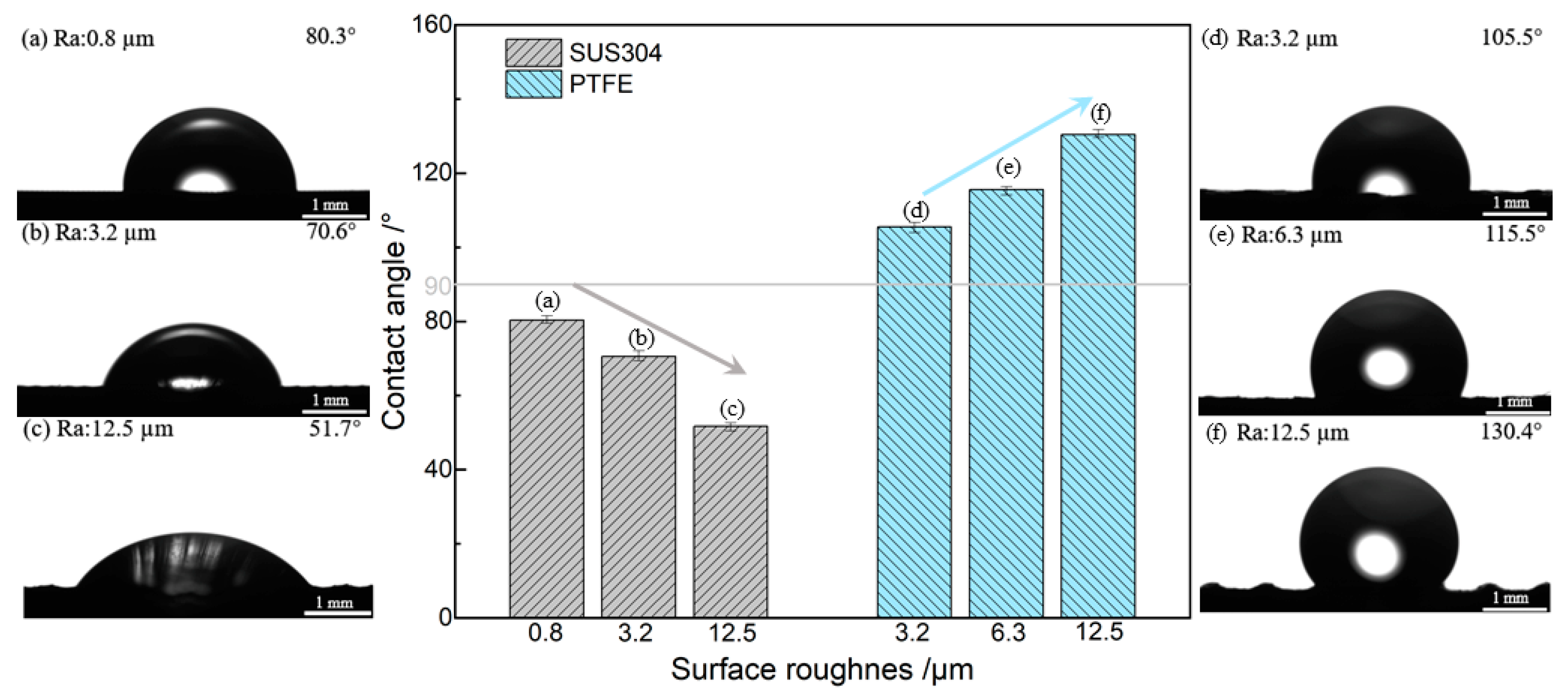
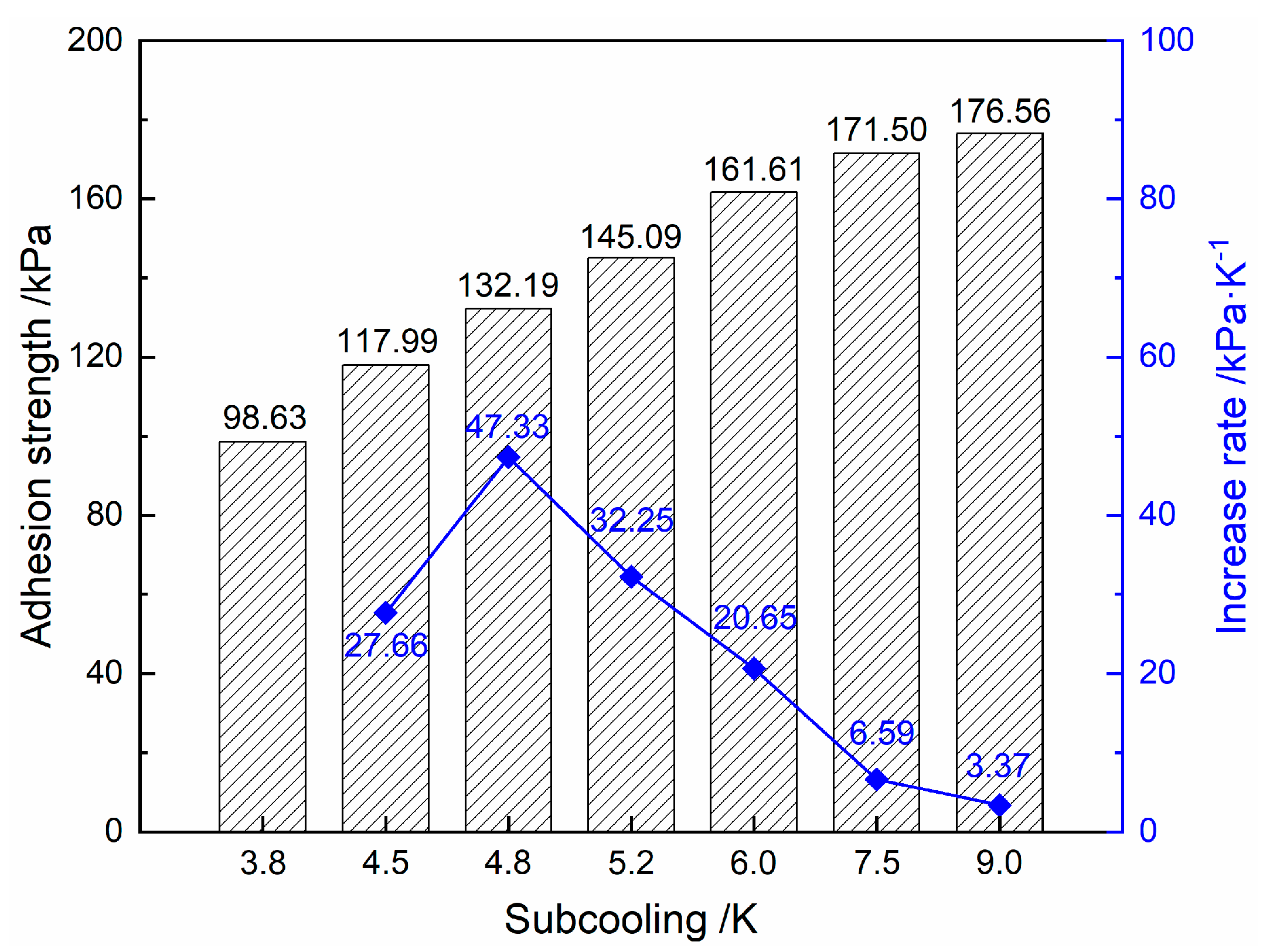
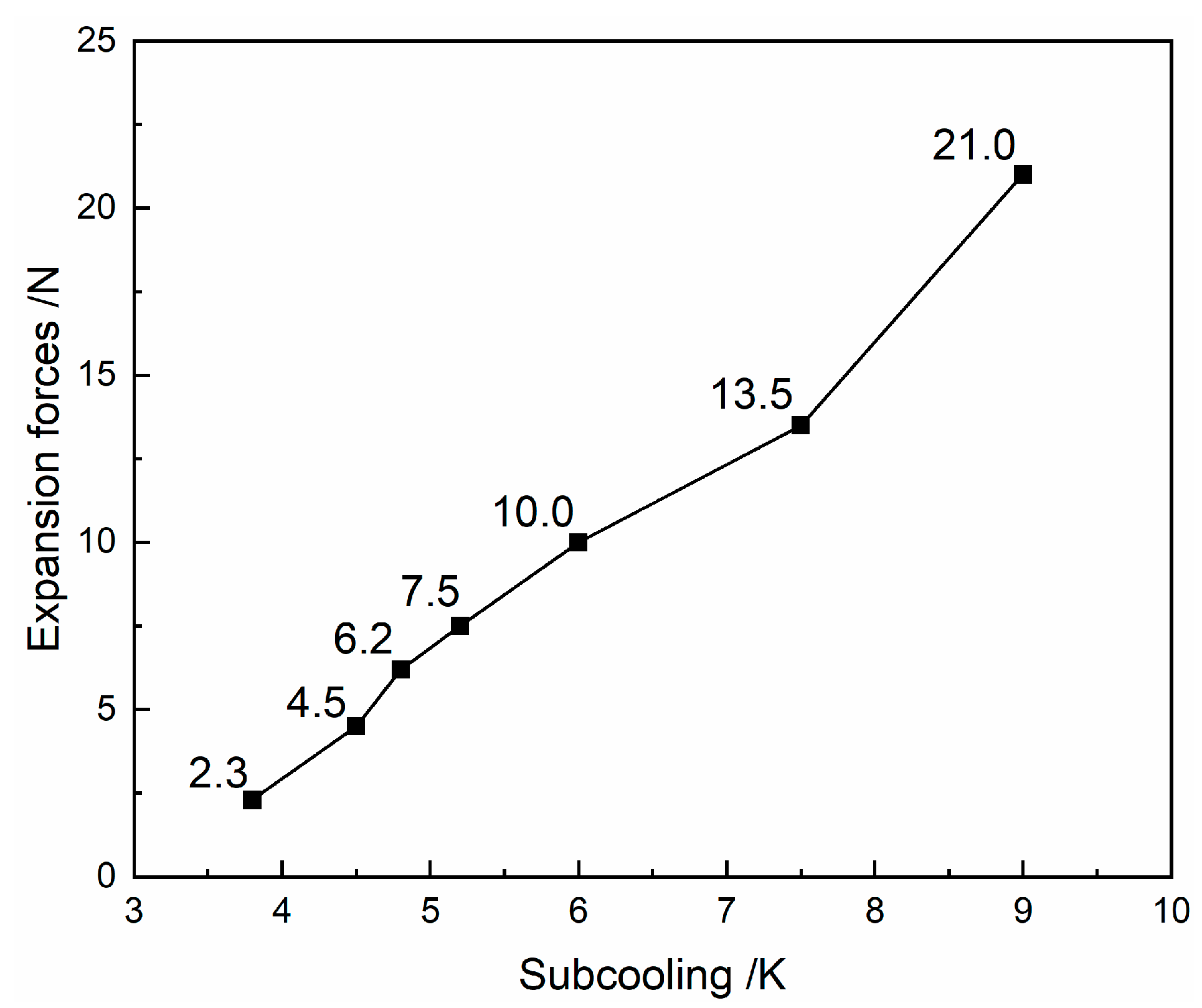
| Solid Surface Material | Ra (µm) | Adhesion Force F (kPa) |
|---|---|---|
| PTFE | 67.30 | |
| 3.20 | 69.85 | |
| 66.31 | ||
| SUS304 | 162.60 | |
| 3.20 | 159.60 | |
| 160.55 | ||
| E355CC | 328.19 | |
| 3.20 | 306.58 | |
| 311.96 | ||
| E235B | 384.92 | |
| 3.20 | 342.33 | |
| 360.36 |
| Medium | Solid Surface Materials | (°) | (mJ/m2) |
|---|---|---|---|
| H2O | E235B | 51.60 | 159.73 |
| E355CC | 61.80 | 131.79 | |
| SUS304 | 70.60 | 107.86 | |
| PTFE | 105.50 | 32.63 | |
| 35 mass% TBAB | E235B | 47.00 | 171.95 |
| E355CC | 55.00 | 150.49 | |
| SUS304 | 64.10 | 125.47 | |
| PTFE | 81.30 | 80.56 |
| Solid Surface | Surface Roughness Ra (μm) | Adhesion Force F (kPa) |
|---|---|---|
| SUS304 | 0.80 | 137.23 |
| 128.19 | ||
| 3.20 | 162.60 | |
| 159.61 | ||
| 12.50 | 384.92 | |
| 342.33 | ||
| PTFT | 3.20 | 66.31 |
| 69.85 | ||
| 6.30 | 73.67 | |
| 70.56 | ||
| 12.50 | 76.90 | |
| 90.53 |
Disclaimer/Publisher’s Note: The statements, opinions and data contained in all publications are solely those of the individual author(s) and contributor(s) and not of MDPI and/or the editor(s). MDPI and/or the editor(s) disclaim responsibility for any injury to people or property resulting from any ideas, methods, instructions or products referred to in the content. |
© 2023 by the authors. Licensee MDPI, Basel, Switzerland. This article is an open access article distributed under the terms and conditions of the Creative Commons Attribution (CC BY) license (https://creativecommons.org/licenses/by/4.0/).
Share and Cite
Xu, Z.; Zheng, L.; Dong, Z.; Liu, A.; Wang, Y.; Sun, Q.; Chen, J.; Guo, X. The Adhesion Strength of Semi-Clathrate Hydrate to Different Solid Surfaces. Processes 2023, 11, 2720. https://doi.org/10.3390/pr11092720
Xu Z, Zheng L, Dong Z, Liu A, Wang Y, Sun Q, Chen J, Guo X. The Adhesion Strength of Semi-Clathrate Hydrate to Different Solid Surfaces. Processes. 2023; 11(9):2720. https://doi.org/10.3390/pr11092720
Chicago/Turabian StyleXu, Zhen, Lei Zheng, Zhen Dong, Aixian Liu, Yiwei Wang, Qiang Sun, Jianyi Chen, and Xuqiang Guo. 2023. "The Adhesion Strength of Semi-Clathrate Hydrate to Different Solid Surfaces" Processes 11, no. 9: 2720. https://doi.org/10.3390/pr11092720








